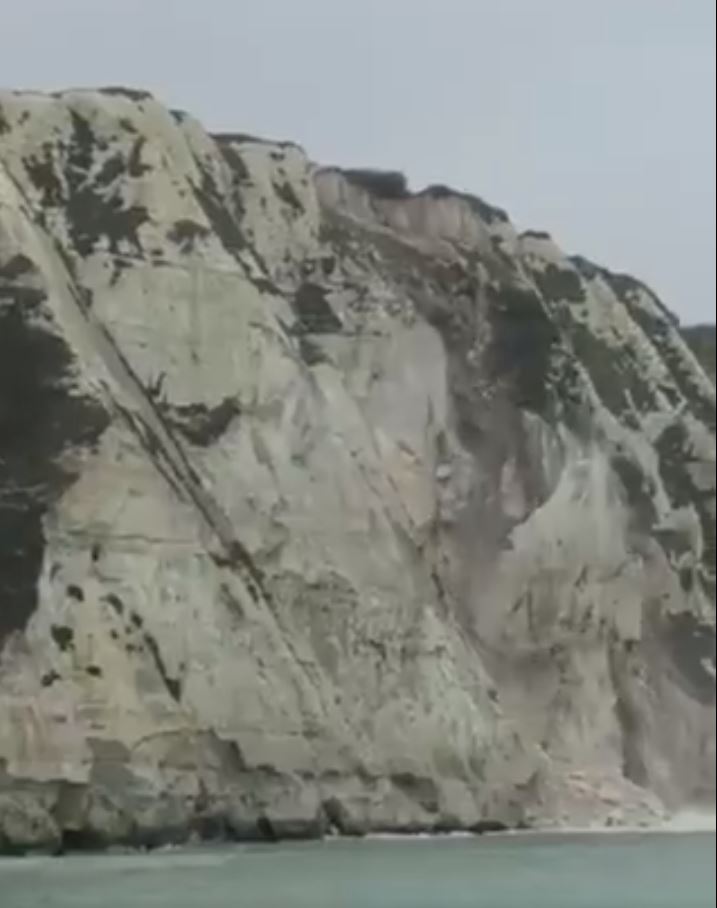4 February 2021
The White Cliffs of Dover chalk cliff collapse
Posted by Dave Petley
The White Cliffs of Dover chalk cliff collapse
A really interesting video was widely circulated on social media yesterday showing a large cliff collapse on the White Cliffs of Dover in SE England. The coverage of the event was quite amusing, with the event being compared to the UK response to the Covid-19 crisis (everything is going downhill) or Brexit (even the White Cliffs are trying to closer to Europe). I have sympathy with both memes.
But the event itself is interesting, not least because it was a large double event. The original video was included in a tweet:-
A large part of the White Cliffs of Dover has collapsed this afternoon. This footage was filmed at Samphire Ho. pic.twitter.com/ycKVf93wiw
— Adam Clark (@adamclarkitv) February 3, 2021
.
I guess everyone can now tell how it is that the White Cliffs of Dover stay white – and such collapses are not unusual. Indeed I wrote about another event like this in 2012.
The event sequence yesterday is interesting though, and the video is valuable. At the very start of the video some precursory rockfalls are seen splashing into the sea, followed by the initial, smaller (but not trivial) collapse. This is followed by the large event a few seconds later.
The main collapse event is shown in the still below:-

The 3 February 2021 White Cliffs of Dover rockfall. Still from a video tweeted by Adam Clark.
.
In the mid section of the cliff there is a large toppling failure, with a big slab of rock rotating away from the cliff. This releases a large volume of more weathered material from upslope:-

The latter stages of the 3 February 2021 White Cliffs of Dover rockfall. Still from a video tweeted by Adam Clark.
.
Large rockfalls from chalk cliffs are well-documented. There is a considerable evidence that smaller falls occur throughout the year, but the largest collapses are associated with the wetter and cooler months. This is probably an indication that moisture in the chalk plays a key role in the development of failure, perhaps through cycles of wetting and drying. It is interesting to note that January in the UK was unusually cold (the coldest January in a decade) and unusually wet.
My colleague here at the University of Sheffield, Dr Lis Bowman (@lis_bowman) has studied these large cliff collapses. The largest coastal chalk collapses have unusual mobility (i.e. they travel large distances), a behaviour that Bowman and Take (2015) suggest may be associated with sturzstrom-like (i.e. rock avalanche) behaviour, which is usually seen in much larger rock slope failures.
.
Reference
Bowman, E.T. and Take, W.A. 2015 The runout of chalk cliff collapses in England and France—case studies and physical model experiments. Landslides 12, 225–239 (2015). https://doi.org/10.1007/s10346-014-0472-2


 Dave Petley is the Vice-Chancellor of the University of Hull in the United Kingdom. His blog provides commentary and analysis of landslide events occurring worldwide, including the landslides themselves, latest research, and conferences and meetings.
Dave Petley is the Vice-Chancellor of the University of Hull in the United Kingdom. His blog provides commentary and analysis of landslide events occurring worldwide, including the landslides themselves, latest research, and conferences and meetings.
I’ve never noticed that wide-spaced seawards dipping joint set before. Not that I know Dover that well. I’m guessing there’s a conjugate set dipping about the dame angle in the opposite direction.
How is it that people STILL don’t know enough to hold their phones sideways when shooting video? Or pretty much any photo?
Please, Was this collapse near St. Margaret’s Bay or Kingsdown? or neared Dover or Walmer??